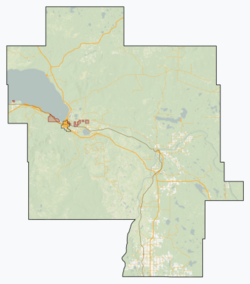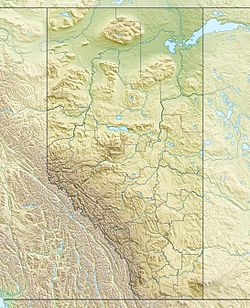Port Cornwall, Alberta facts for kids
Quick facts for kids
Port Cornwall
Fort Cornwall / Mirror Landing
|
|
|---|---|
|
Former village
|
|
| Country | Canada |
| Province | Alberta |
| Region | Northern Alberta |
| Census division | 17 |
| Municipal district (MD) | MD of Lesser Slave River No. 124 |
| Incorporated (village) | October 27, 1913 |
| Dissolved | September 11, 1917 |
| Government | |
| • Type | Unincorporated |
| Time zone | UTC−07:00 (MST) |
| • Summer (DST) | UTC−06:00 (MDT) |
| Area code(s) | 780, 587, 825 |
| Waterways | Athabasca River, Lesser Slave River |
Port Cornwall, also called Fort Cornwall, was once a small village in northern Alberta, Canada. It was part of the Municipal District of Lesser Slave River No. 124. Before it became a village, people knew the community as Mirror Landing.
Port Cornwall was located on the north side of the Lesser Slave River. This was right where it met the Athabasca River. Today, the Hamlet of Smith is about 1.4 kilometers (0.9 miles) southeast. It sits across the Athabasca River from where Port Cornwall used to be.
Contents
The Story of Port Cornwall
Early Days as Mirror Landing
In the late 1800s, Mirror Landing was an important stop for travelers. People going to the Peace Country from Fort Edmonton would pass through here. They often traveled by way of Athabasca Landing. By 1911, Mirror Landing was one of many places where steamboats could stop. These boats traveled freely between Athabasca Landing and Lesser Slave Lake.
Becoming a Village
The community officially became a village on October 27, 1913. It was named the Village of Fort Cornwall. However, people started calling it Port Cornwall as early as January 1914. According to Alberta Municipal Affairs, Port Cornwall had about 200 people living there in 1913.
Life in the Village
By early 1914, Port Cornwall was a busy place. It had more than 30 businesses and many homes. The village even had streetlights and sidewalks. There was also a government telegraph office. The Royal North-West Mounted Police had quarters there too. Plans were also being made to build a school and a Methodist church.
The End of the Village
However, early 1914 also marked the beginning of the end for Port Cornwall. The Edmonton, Dunvegan and British Columbia Railway reached a new spot. This spot was the current location of Smith. It was right across the river from Port Cornwall. Because of the railway, a new townsite for Smith began to be developed. This started the decline of Port Cornwall.
Eventually, the Village of Port Cornwall was officially dissolved. This happened on September 11, 1917.



